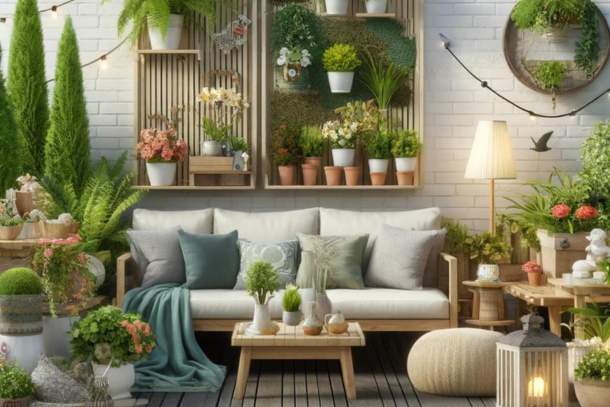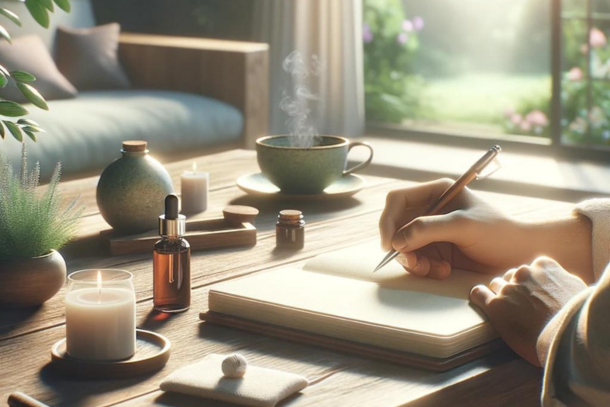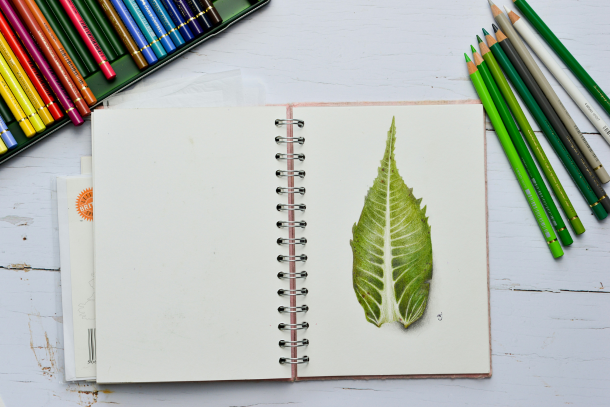Biophilic Design for the Bedroom and Offices

To be biophilic refers to the human tendency to interact or to want to be closely related to other forms of life that are within nature. Biophilia refers to the love of nature.
What is biophilic design?
Biophilic design refers to the practice of being in or creating buildings and landscapes that are closely connected through nature. To have a biophilic design means to use nature and natural resources as a method to create a connection between the natural world and modern buildings and landscapes.
It is a type of design that dates back centuries but was coined by Erich Fromm in his book, The Anatomy of Human Destructiveness in 1973. First considered a philosophy by biologist Edward O. Wilson in his book Biophilia (1984), where he outlined a hypothesis that stated humans have an innate and biological understanding and likening for the natural world. The idea of this as a design takes this notion further and encourages it to be used by bringing the outdoors inside. We, as humans, spend most of our time inside, therefore if we have this biological understanding of the natural world, it only seems plausible that we would try and incorporate that where we spend most of our time.
There are different ways in which we are able to incorporate biophilic designs into modern architecture, such as:
Light and dark
Our circadian rhythms, which are the physical, mental and behavioural changes within a 24-hour cycle, can contribute massively to our health. It shows that having balanced circadian rhythms that are in line with daylight and nighttime are beneficial to our health. Having spaces in your house that cater for sunlight/and or darkness and shadows can be a great way to the outdoors with inside.
Air
Allowing fresh air to circulate the building and/or home allows us to incorporate different weathers outside into the home. For example, we will be able to hear the rain, thunder and feel the fresh air. Ensure that the building allow for windows to be opened, so that you can experience this. Not doing this can cause the inside to become stuffy and not very well ventilated.
Incorporate natural elements
Bringing natural elements into the home can make us feel better connected to nature. This can be done in different forms, through the use of green paint, which has strong connotations to nature and natural imagery. An alternative form is plants. Putting some indoor plants within your house can make your connection to nature much stronger.
Natural textures
Using natural textures throughout your house can be a way to further enhance bringing the natural environment into your home. These textures can be as followed:
- Wood
- Stone
- Clay
Other natural textures can be used in addition to those listen above to replicate natural environments.
Skylights
Building and/or homes that have a skylight can be great for bringing in natural light. This is better for us than the use of artificial lights. In addition, they can also provide a great way to let fresh air enter the building. On days where the sun is shining it allows for natural warmth to enter the space.
Water
Bringing water into your home, even in spaces such as garden and greenhouses can make you feel connected to nature. The presence of water, through fountains or ponds, can create a relaxing atmosphere, with a nice aesthetic. An indoor water fountain can improve air quality and double as a humidifier.
How to create a biophilic bedroom
For many of us, one of the most relaxing place can be our bedroom. Therefore, it can be particularly inviting for us to incorporate a biophilic design into the bedroom. This can be done by doing the following:
Fresh Air/Windows
Ensure that your bedroom is space that has windows. These should be windows that can open and that you are comfortable to open. Bringing fresh air into the bedroom will aid the ability to create a biophilic bedroom.
Natural Light
If your bedroom has curtains or blinds, then ensure that this are open when the chance for natural sunlight is there. If one room in the house gets access to more sunlight than the others, consider making this your bedroom.
Plants
Bringing some indoor plants into your bedroom can act as a natural air purifier and if you are someone who loves nature (chances are if you want a biophilic room then you are) then it can help to boost your mood. Some of the best plants to use in your bedroom are:
- Snake Plants - This is a popular houseplant due to it not needing large amounts of light and its ability to thrive with little water.
- Monstera - A monstera plant is great for aesthetically pleasing bedrooms and requires moderate light and weekly watering. It can be great to add a natural feeling to the bedroom. If you have small animals, be careful with this type of plant.
- Anthurium - This is a really eye catching house plant that has bright coloured flowers. The bright coloured flowers give a pop of colour within the green leaves.
- Parlor Palm - A parlor palm is a fairly big houseplant, but is great for filling an empty space.
Vertical Plant Wall
Another inventive way to bringing plants into the house and bedroom is by creating a vertical plant wall. This involves a vertical structure that hold different types of plants and greenery. It is a creative way to bring both the colour green and plants into a household and building setting. Some of the best plants to use in order to achieve this are:
- Succulents - Succulents do not require much attention and they can grow easily making them a great plant to use for a vertical plant wall.
- Herbs - Herbs can be incorporated into a vertical plant wall and this can also benefit as a way to grow your own herbs for consumption. They grow quickly and can be a great addition.
- Vines - These are low maintenance and can be placed in direct sunlight.
- Hardy Fuchsias - These are a nice flower plant that can add a pop of colour to a vertical plant wall.
Green Colours
Try to use the colour green. The colour green has strong connotations to nature and natural imagery and using green colours within your bedroom can aid relaxation and restore energy. Ways you can bring green into the bedroom are as followed:
- Green wallpaper/paint
- Plants
- Furniture
Natural Materials
When furnishing your bedroom, try to use natural materials such as bamboo, stone and wood. This can be done by place a chair, made with the material of natural wood in your bedroom. Furniture that can be natural is as followed:
- Bed Frames
- Wardrobes and other units
- Accents
- Sofa and Chairs
How to create a biophilic office
For those who work in an office, we can end up spending a lot of time in there. If you are creating an office for your staff or you have a personal office, you might be looking to make it more biophilic.
Ensuring that your staff have access to natural light is important when attempting to create a biophilic office. Most offices are made up of artificial light and this can increase stress levels, and long exposure to artificial light can have negative effects on our health by inducing headaches and having an effect on the immune system.
Outside working can be another effective way to incorporate the notion of a biophilic design. If possible, create outdoor working spaces that are filled with seating and comfortable working equipment. It is thought that this can encourage productivity, creativity and ensure the wellbeing of your staff whilst they are at work.
When decorating the office, use colours that are natural, such as blue and green. Green is a common colour that is used for offices because it provides balance and it is the easiest colour for the eyes as no adjustment is needed. You can also decorate the offices with plants and other natural textures. Make sure the desks, chairs and furniture are made of as much natural materials as possible.
Why are biophilic designs important?
Biophilic designs are important for a variety of different reasons, but these reasons will be more beneficial depending on the space in which you are creating.
Biophilic designs have shown to reduce stress, improve your cognitive functions and enforce creativity. In areas such as the bedroom, an office and your home spaces, you may want to biophilic design as it can reduce stress and these are the spaces where you are more inclined to experience this or where you are less inclined to want to experience it.
These can be easily incorporated and in most cases, a large budget or space is not needed. It is beneficial to ensure that whilst we build and live in nature that we continue to capture and maintain the connection that we as humans have with nature.
If you are looking to bring biophilic designs into your home, this can create a calm and restorative environment where it is arguably most important.
Biophilic design in architecture
Biophilic design is an approach that is used within architecture that intends to connect buildings more closely to nature and natural depictions. This can be done by including natural lighting and keeping the natural landscapes when planning and building structures. This is done with the intention of creating spaces that are more beneficial for productivity and healthy environments.
The work of Antoni Gaudi, the Catalan architect is a great example of biophilic design and influence. From the start, his buildings mimic and draw on nature for inspiration. And it is through his harmony with nature that he was able to achieve a naturally airconditioned environment without the need for mechanical means. His use of airflow can be seen in the design of termite mounds, creating natural airflow and cooling effects when needed. His inspirational biophilic design is still so far ahead of its time, and yet timeless in that it could operate in a period before modern air conditioning. Such biophilic architecture did not draw on energy to create its effects and in this world of hungry energy needs to control the atmosphere of a building such architects are worth revisiting, to learn from their simple elegant, biophilic design.
Below we have outlined some of the most architectural designs that have really adopted the idea of a biophilic design (sourced from Design Wanted).
- One Central Park - Sydney, Australia
- Garden House - Beverly Hills, USA
- Bosco Verticale - Milan, Italy
- Barbican Centre - London, UK
- Private Residence - Tokyo, Japan
- The Jewel - Singapore, Singapore
- Second Home - Lisbon, Portugal
- Amazon Sphere Headquarters - Seattle, USA
- Ha Long Villa - Ha Long, Vietnam
- Naman Pure Spa - Danang, Vietnam
- Planted Pergola - Tokyo, Japan
These places are attempting to achieve a connection between citizens and nature within a modern building environment. It attempts to bring the environment and nature together with modern infrastructure in modern urban spaces. In the process of this, it is important that you consider how the biophilic design is a response to the environment that is around it.
If more buildings were to incorporate biophilic design then more structures would become alive to the beauty of their surroundings and take on a more environmentally friendly, lower energy consumption, more in harmony with nature aspect. This in turn would benefit all who live and work in such buildings. Biophilic design is a design principle we all need to adopt.
Related to this article are the following:
I do hope you have enjoyed this article and hope that you will subscribe to my newsletter so you can get the latest information about all things naturally relaxing.
Stay in touch, join the Naturally Relaxing Newsletter
Newsletter Signup
Post Your Comments
or post as a guest
Be the first to comment.
Latest articles in Lifestyle

DIY Natural Beauty Treatments for Glowing Summer Skin

10 Natural Remedies to Combat Summer Allergies

How to Create a Relaxing Outdoor Space for Summer

Mindfulness Techniques to Reduce Stress in Your Daily Life

Hydration and Wellness: Natural Ways to Stay Hydrated in Summer






